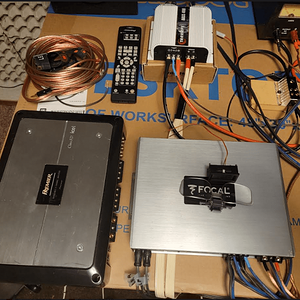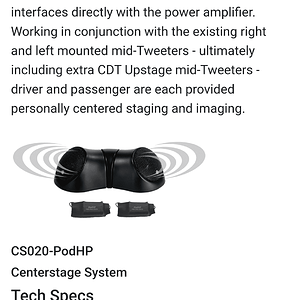I'm an audio engineer. I haven't read other answers but I would say that this depends entirely on preference, however, it would be nice to know either the -3dB and -10dB drop off frequencies for both speakers, this can influence your decision.
Personally, 100Hz is a little high if you enjoy bass heavy genres of music like EDM and Hip-hop, but it's perfect for rock, country and alternative music.
There are two types of bass: you have your bass and then you have your sub-bass which is an entire octave lower than your traditional bass levels.
The bass region includes most bass guitars, toms, some brass instruments like the tuba and trombone, but it especially includes the kick drum.
Your sub-bass region is hard to hit with natural instruments, but it can be reached by large enough toms and kick drums, and also the piano, which includes bass guitars fitted with large piano gauge strings (like Korn, Slipknot and other heavy metal bands), but the sub-region is mainly incorporated into songs with the use of synthesizers, so if you aren't listening to rap, trap, edm, dubstep, house, future bass, etc, etc... then it's not really advisable to focus on cleaning up this region of the sound spectrum.
Above your bass comes the mids and the highs. How you set your crossovers is basically deciding the balance of your music. If you prefer a cleaner high-end, then you want to send less low-end and mids to your main speakers, but this will muddy up your low-end and actually make your sub-bass region weaker to nearly non-existant...
You can do this by setting the low pass as high as it goes (preferably no higher than 100hz) and matching that with your low pass. As it sits right now, this is going to be your setup.
If you want the cleanest "sub" bass frequencies then you'll want to set your low pass at either 50 or 63Hz and no higher than 80hz. This will take away from your high end since you are now sending more of the audio spectrum to your main speakers, but this can be easily offset with EQ. If you can, just boost anything above 8kHz and you should be good.
EQ works well for high end, but this same technique cannot be applied to the low-end. Boosting low-end with EQ is not really advisable... any form of EQ ALWAYS adds distortion to both sound but more importantly to phasing, which can actually add to your high-end but it can muddy up your low-end and actually make it sound weaker.
If you really want to know why, then study additive synthesis, or better yet, look up the frequency of a pure sine wave, then look up a sine wave + a sine wave with a ratio of two. The amplitude of the original sine wave is diminished by the addition of a sine wave one octave up (meaning its muddy). This happens with all distortion because distortion always adds higher harmonics to your fundamental frequency.... to sum this up in lamens terms, option 2 is usually better (but again it comes to preference).
Also, you don't want any overlap in your crossovers. You might think "the more speakers playing the bass frequencies, the louder it is", but this is not true at all... it introduces phasing and "phase modes", which are notorious bass killers, so never let the crossovers overlap, and if your high pass gives you a range (like 80 to 100hz) this is because filters taper off, usually at -12dB per octave, so if you set your filter to 100hz, you are beginning your filtering at 100hz, but it is still audible down to 80hz and beyond (but only to a negligible degree after 80hz), Personally, I'd set your low pass to match the lower end of that high pass range (80Hz), and if you don't care for it then try 90hz, then 100hz.
One last thing, the frequency response of your speakers is not as accurate as the spec sheets claim. If your speakers claim to go all the way down to 50Hz, then this is either their -10dB cutoff point or their -3dB cutoff. Knowing which it is- is very helpful, because if they are advertising their -10dB benchmark (meaning that at 50Hz, the sound dropped by -10dB, which is significantly quieter than -3dB) then this isn't accurate.
If the rating is referring to its -3dB cutoff point, then you can say that it is truly capped at 50Hz, but if it is referring to its -10dB point, then it's cap is much higher than this. The -10dB cutoff is the point where the frequencies start to become entirely inaudible, and the -3dB cutoff is where the audio first becomes noticeably quieter but still audible (it gradually decreases after this until it's inaudible) but companies will market their speakers using the -10dB cutoff, in order to trick people into believing their speakers go lower than they actually do, when in reality the speakers are incapable of reaching that frequency to effect.
Hope this helps, and if you want me to possibly elaborate more or want pics, or have other questions just let me know.


